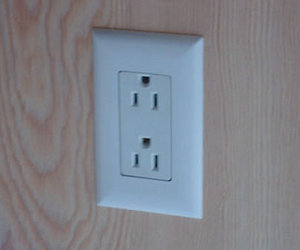Replacing a 2-wire receptacle is not a difficult task to perform but it is often incorrectly done. An incorrect installation can result in a risk of fire or injury from an electrical shock. You have several options to correctly and safely replace a 2-wire receptacle.
Older homes will often times have 2-wire or 2-prong receptacles as they are sometimes referred to installed. These receptacles often wear to the point where to do not allow for a solid connection to appliances that are connected or simply do not work. You may also want to replace the outlet to fit grounded plugs.
You have a few options when replacing 2-wire outlets and all of these options will meet the code.
Replace the receptacle with a new 2-wire receptacle.
Replace the 2-wire receptacle with a GFCI receptacle and mark the outlet with “No Equipment Ground”.
Replace the receptacle with a normal 3-prong receptacle then replace the circuit breaker with GFCI-type breaker. Mark the receptacles on that circuit with “No Equipment Ground” and “GFCI Protected”.
Replace the wiring to that outlet with the proper three wire cable.
Before you attempt any of the above repairs always turn the power to the circuit off at the breaker box and verify that the power is off at the receptacle with an electrical tester. Once you are confident that the power is off you can proceed to replace the receptacle.
To replace the outlet with a new 2-wire receptacle you will need to pay attention to how the old one is connected. The screw terminals are color coded on the receptacles. The brass or gold colored screw connects to the black “hot” wire. The silver colored screws will connect to the white “neutral” wire.
Just remove the wires from the old receptacle and connect the new receptacle according to the above mentioned color code. Carefully fold the wires back into the box and attach the outlet to the box. Replace the cover plate and you are finished.
A much safer option, and still a very easy installation, is to replace the receptacle with a GFCI receptacle. Once again you will simply remove the old receptacle and replace it with the GFCI outlet. Be sure you follow the same color code black wire on the brass screw and white wire on the silver screw. You won’t use the green screen.
Install the receptacle back in the box and install the cover plate that is provided with the GFCI. The GFCI receptacle will come with the appropriate stickers to mark the outlet “No Equipment Ground”. Put that sticker on the cover plate.
Once you have replaced a 2-wire receptacle with one of the options above turn the breaker back on. Test your outlet with an electrical meter to verify that you have a proper voltage range. You should find that the voltage will read from 110 to 130 volts on your electrical meter.
Replacing the circuit breaker is yet a third option and can be much more difficult. This requires you to work in the breaker box with you hands in close proximity to energized electrical parts. I do not recommend this installation to the typical do it yourselfer unless you are sure that you know what you are doing and can do it safely. This installation is beyond the scope of this article so I will explain it in more detail in another article.
The last option you have is to re-wire the circuit with a three wire cable. This again is a more difficult task that should be done by a qualified electrician. However I will also explain this in a future article for those that feel comfortable working in their breaker box and pulling wire.
Replacing a 2-wire receptacle is an easy task that most people can do themselves. Always be sure the power is turned off to the circuit and verify with an electrical tester or meter. Always tighten the screws on the receptacle well, a good mechanical connection between the wire and screws will ensure that the circuit operates properly. As a final step always verify the voltage at the receptacle with an electric meter.





